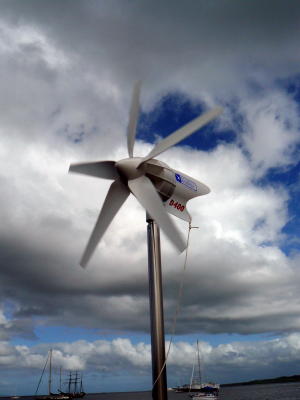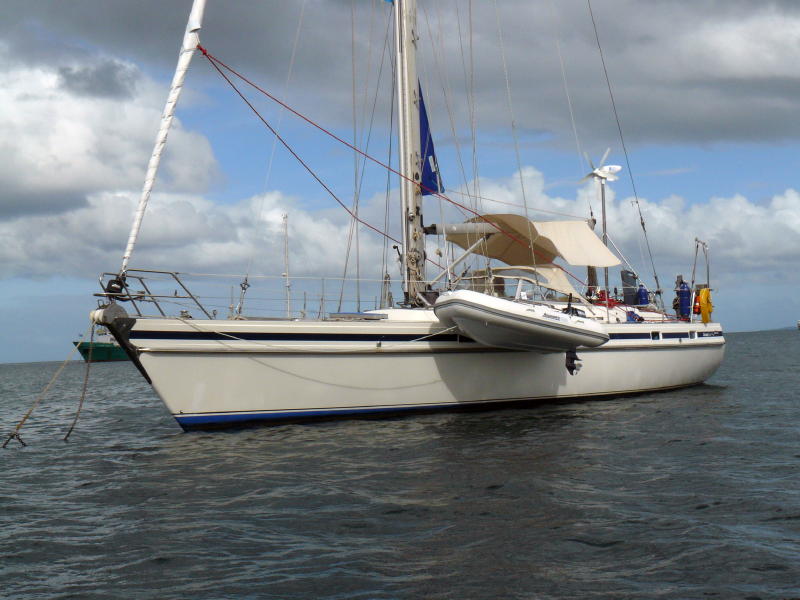New Zealand to Fiji

JJMoon Diary
Barry and Margaret Wilmshurst
Sat 31 May 2008 05:24
|
A couple of days out of Opua I settled
down to write a quiet, reflective piece about the pleasures of New Zealand as a
venue for a six-month stopover including gentle critical comment on some aspects
of life and the environment. But the wind was piping up, I was wedged into
one end of the navigator's seat and there was danger of water splashing on to
the computer. My heart wasn't in it.
We were
heading north, the wind was increasing from the north-east and soon we were hard
on the wind at the top end of force 7. We were sailing through a
depression and associated trough of low pressure and for four days we struggled
with winds of 30 to 40 knots with fairly frequent gusts of up to 45 knots (a
gale, force 8, has winds of 35-40 knots and sustained winds of 40-45 knots are
represented as force 9). Our canvas bimini cover (sun shade) was shredded
in 40+ knots but we managed to salvage sufficient pieces to provide a pattern
for a new one and to fold down the stainless steel frame so that it could do no
harm. The port navigation light was washed off its bracket and smashed and a
block on the boom burst apart. We also took quite a bit of water aboard – it
seems to find any number of ways to get below if the weather is bad enough - but
with good foul weather gear we managed to keep warm and dry and to keep going,
which was more than many boats in the area who hove to to take the pressure off
and give the crews some relief. As we passed through the system the wind
backed into the north-west so we tacked but the change created chaos in the wave
pattern. At the same time the barometric pressure started to fall “like a stone”
and was soon outside Bob McDavitt's parameters. Gulp! I asked the weatherman for
an up-date but to our relief he remained fairly optimistic. Eventually the wind
moderated, the chaotic swells reduced in height and gradually conditions became
pleasant. We have since heard several tales of brilliant repairs carried out in
terrible conditions.
At midnight in
the height of the gale the satellite phone rang – a most unusual
occurrence. Mags was on watch and having un-hitched and struggled down
below she found a polite young man on the line asking whether we were “all
right”. Each party asked to identify the other and it turned out that the
New Zealand Maritime Safety Service had received a couple of e-mails from our
good friend Ray Brown in Switzerland. He follows our progress closely and had
noticed that we were in an area of force 9 winds and that our blog positions
were not being progressed across the ocean (we have not yet found out
why). He e-mailed NZMSS who replied that as our Electronic Position
Indicating Radio Beacon (EPIRB) had not been set off and they had received no
emergency call by radio there was little they could do. After twenty-four
hours Ray was still concerned so sent another e-mail telling the Safety Service
that he was sure we had a satellite phone but he did not know the number.
The NZ authorities did; hence the call. Almost the subject of an
“incident” then, but we were greatly comforted that people out there in the
warm, dry world were sufficiently on the ball to keep an eye on us.
Having dealt
with her young man Mags was moved to check the number of pre-paid minutes on the
sat-phone. Only 4! We must get it topped up by e-mail but if we used the
remaining minutes doing that and failed to extend our balance before 0800 Y-Not
would call (more trouble with the SSB radios somewhere), get no reply, and might
conclude we were in trouble! Fortunately Ed. our sat-phone supplier was in
his office, efficient as usual and we were up and running again in good time.
Once again we were grateful to be doing this in a period of excellent and
improving communications.
On reflection
I made a mistake. We should have waited another 4 or 5 days. Like others I
had previously been sniffily critical of I got a bit carried away by the bustle
of departure and a bit too dismissive of the gloomy prognostications and
warnings that always swirl around fleet departure points. We had a
detailed passage plan from McDavitt but I forgot that he is not a sailing man
and cannot quite relate his wind strengths and swell heights to real conditions
in a small boat at sea. In addition, his forecasts are written in
meteorological code. The key is provided but I should have spent more time
deciphering and studying the details and not relied so much on his introduction
and my first impression that it would be “not the best of passages, but not the
worst”. One hopes to have learnt a lesson but fears that it is all too
easy to fall into the same error. It was notable that some boats that left
several days before us, in the very middle of what was supposed to be an ideal
“window”, fared just as badly.
We were really
not quite ready to leave. For one reason or another we never fulfilled our
firm plan to have a short cruise in the Bay of Islands to make sure everything
worked. After 6 months it took us twenty-four hours at sea to remember what to
do and where everything should be stowed.
One big
consolation was the full moon. It is astonishing how good it is for morale
to be able to see the horizon and where the boat is heading.
Anyway, at
last we have a ready answer to the question that is so often put: “but surely
you must have had some bad bits?”
 The
new wind generator is fulfilling its promise. As the wind rose in strength it
was able to cope with all our electrical needs and we were just beginning to pat
ourselves on the back when it caught its own braking line, suffered a complete
wrap around and stopped with a clunk. It was too dangerous to climb the
slippery pole until the weather calmed down but then it was soon cleared and
suffered no lasting harm. A small adjustment should prevent the same thing
happening again.
So we are back
in Fiji. We have dealt with the mountain of paperwork aided by the most
courteous and helpful officials, remembered how to use carbon paper and are set
up, administratively, to cruise the islands. We must now get a new bimini made
and import a replacement nav. light. We have started these processes and
it is no hardship to spend some time on the business in and around the Royal
Suva Yacht Club. We shall probably be at anchor here for a week or
so.
Like everybody
we have spoken to we were sorry to leave New Zealand. We were made most
welcome by people who seem, on the whole, to cherish their British connections,
however distant. The climate is not dissimilar and the way of life
includes many reminders of life back home, if more relaxed. Perhaps we
should return one day?
We left Opua
after lunch on Saturday 16th May and arrived in Suva at 0930 on
Monday 27th having covered 1125 nautical miles. Over the last 2 days
we regulated our speed so as to pass through the reef in daylight - not
essential at Suva, but sensible.
 Our new aluminium bottomed inflatable dinghy hanging from the spinnaker halliard where it is stowed at night. This method of stowage has several advantages:
it keeps the dinghy from filling with rain (we take out the plug);
it keeps it secure (2 tenders were stolen from anchored yachts just
before we arrived);
and it keeps the bottom clean.
|